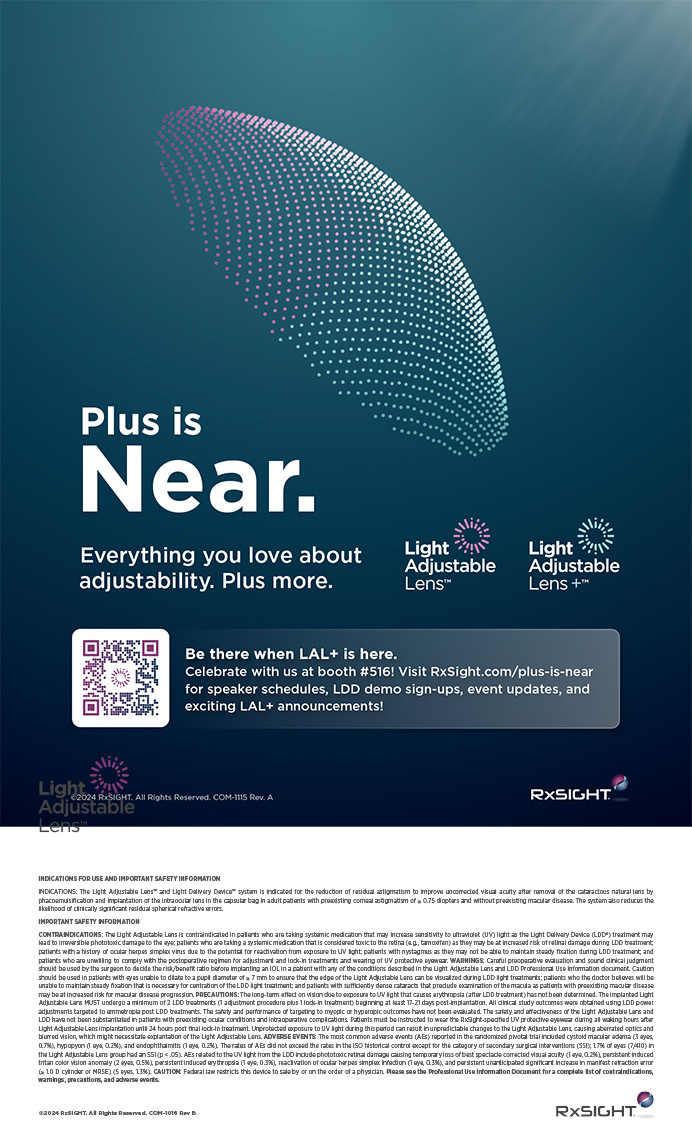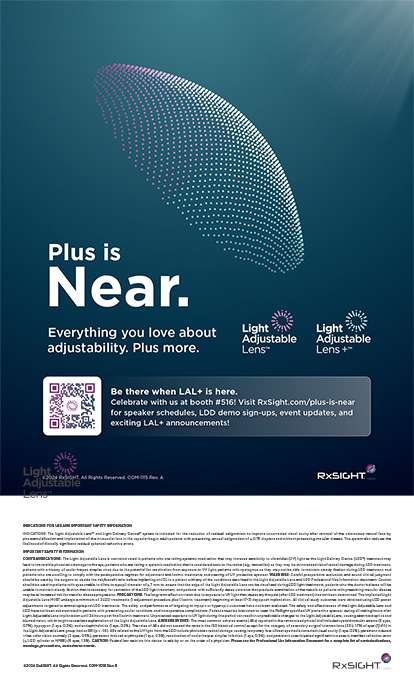Although flap complications with the IntraLase FS femtosecond laser (IntraLase Corp., Irvine, CA) are uncommon, it is important for a surgeon to know how to approach situations such as loss of suction, incomplete passes, and decentered flaps as they arise. After evaluating the condition of the eye, it is important to determine whether it is safe to continue with the procedure as planned, delay the surgery, or abort it altogether.
SUCTION BREAKS
If a suction break occurs during an IntraLase procedure, it is best to immediately stop the procedure and analyze what may have caused it. Two rather common reasons for this complication are improper seating of the suction ring with entrapment of conjunctiva or lashes under the ring and a nervous patient who squeezes his eye uncontrollably. Once the cause of the suction loss has been identified, the surgeon has to decide (1) whether or not to reattempt surgery on that eye on the same day, and (2) whether or not to proceed with surgery on the second eye.
If it is possible to identify and manage the cause of the initial suction break, and if the patient agrees, I would likely perform the procedure on his second eye. It may also be possible to reattempt flap creation in the first eye on the same day, depending on the circumstances (which I explain later). If the patient is not comfortable enough to proceed with surgery, I would then wait and come back to reattempt the first eye at a later date and proceed with the second eye at that time.
If the suction breaks while cutting into the visual axis, I do not recommend reattempting the flap on the same day because there may be irregularity of the lamellar bed at the junction of the initial and second procedures. Instead, I would come back at a later date and reattempt creating the flap at least 40 ?m deeper than the initial flap depth.
If the lamellar cut was aborted before entering the visual axis (or after leaving it), however, it may be safe to proceed with surgery on the same day. In this instance, I would re-establish suction—using a new ring—and finish the procedure as I originally intended, at the same depth. It is also safe to continue with flap creation on the second eye as planned.
If a suction break occurs during the side cut portion of the procedure, it is important not to attempt to lift the flap, as it may tear. Instead, re-establish suction with a new suction ring, and repeat the side cut using the "side cut only" treatment option. However, it is important to reduce the flap diameter by 0.5 mm to avoid tracking into the original side cut.
INCOMPLETE PASSES
Incomplete passes during flap creation can occur for other reasons than a suction break, including irregularities within the applanation glass of the laser cone, debris caught within the interface between the applanation cone and the cornea, corneal opacities, vertical gas breakthrough, or laser malfunction. It is important to watch for the uniform formation of the opaque bubble layer as the flap is being created to ensure a complete lamellar cut is achieved. If there is concern that an incomplete cut has been achieved, it is important not to lift the flap, due to the risk of creating a tear.
Similar to when a suction break occurs, upon recognition of an incomplete cut, it is important to stop and assess what may have gone wrong. Examine the cornea for unrecognized opacities, and examine the applanation cone for opacities within the applanation glass. If the problem can be found and successfully managed, it may be safe to reattempt flap creation on the same day, with a new applanation cone and suction ring. As with a suction break, if the incomplete lamellar cut is not within the visual axis, then it may be safe to repeat the cut at the same depth. If, however, the incomplete portion of the cut is within or near the visual axis, it is advisable to halt the procedure and repeat the cut on another day, at least 40 ?m deeper than the original cut. In these cases, however, surgeons must be aware of how much corneal tissue is available, and whether there is enough to support a 40 ?m thicker flap. Otherwise, a surface procedure is a better option if there is insufficient corneal tissue. Similarly, if the incomplete cut was found to be due to a previously unrecognized corneal opacity, it is best to convert to surface ablation at a later date.
CENTRATION
Flap centration is a critical part of the IntraLase application. The IntraLase system allows control of proper centration in two ways. First, the suction ring is centered either on the pupil or on a central mark on the cornea by direct visualization. There is less sliding of the IntraLase suction ring than with most microkeratome systems. Secondly, the placement of the proposed lamellar flap is directly adjusted on the IntraLase video screen.
When I place the suction ring on the eye, I will offset it a bit superiorly to allow enough room for the pocket formation. When docking the applanation cone to the suction ring, it is important to hold the suction ring perfectly level and to watch the applanation meniscus, both under the microscope and on the video screen. If the meniscus is not symmetrical or even, the suction ring must be tilted, usually in a direction that is counterintuitive, to re-establish a symmetrical meniscus.
If a flap is significantly decentered after its completion, do not attempt to lift it. I think a better course of action is to reattempt a properly centered flap within the confines of the initial flap. To ensure that the side cuts are not crossed, I make the flap diameter a bit smaller.
OTHER COMPLICATIONS
Anterior Stromal Scars
If the scar is mild and not too dense, the IntraLase can cut through it. In the presence of moderate-to-dense scars, I consider either using a traditional microkeratome or performing a surface procedure to avoid the possibility of an incomplete cut with the IntraLase. If the latter occurs, it is possible that I will not be able to lift the flap in that area, thus increasing the risk of a corneal tear or buttonhole.
Mini Buttonholes/Vertical Gas Breakthrough
Vertical gas breakthrough (gas tracking anteriorly through the epithelium) can occur due to attempting to create a flap that is too thin, focal breaks in Bowman's membrane from previous infection or trauma, or a loss of suction. In the area of the gas breakthrough, the tissue may not be completely cut. Consequently, attempting to lift the flap may tear the tissue and create a true mini buttonhole in that area. Generally, in this case, I would suspend treatment with the IntraLase, I would not attempt to lift the flap, and I would reattempt to create the flap at a later date with a cut 40 to 50 ?m deeper cut. If the side cut had already been completed on the first attempt, I would also decrease the flap diameter by 0.5 mm. If the residual stromal thickness is inadequate for a deeper cut, I think surface ablation is the best option. Also, if the integrity of the epithelium is compromised at the time of the gas breakthrough, I would switch to surface ablation.
Epithelial Slough
Epithelial sloughing may occasionally occur with an IntraLase procedure, usually due to unrecognized basement membrane dystrophy or a vertical gas breakthrough. In these cases, I recommend converting to a surface ablation procedure, which is safer for two reasons. First, the patient may suffer from unrecognized basement membrane disease for which the surface procedure will have a therapeutic benefit. Second, eyes with epithelial sloughs have a greater chance of diffuse lamellar keratitis as well as epithelial ingrowth. I also recommend continuing with a surface ablation in the second eye because of the likelihood of a similar epithelial slough in that eye as well if an IntraLase flap is attempted.
CONCLUSION
Overall, the IntraLase procedure offers surgeons and patients a better safety profile with fewer, less severe potential complications than mechanical microkeratomes. When complications strike, however, a surgeon who is prepared with a plan of action will be able to handle the rare complications when they do occur and achieve a successful outcome.
Jodi I. Luchs, MD, is Director, Department of Refractive Surgery, North Shore/Long Island Jewish Health System, in Great Neck, New York. Dr. Luchs acknowledged no financial interest in the product or company mentioned herein. Dr. Luchs may be reached at (516) 785-3900; jluchs@aol.com.


